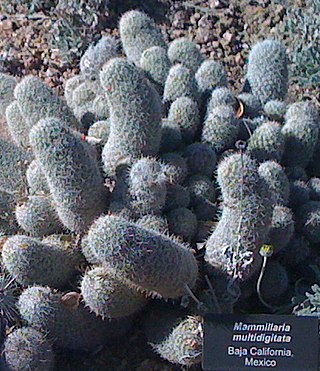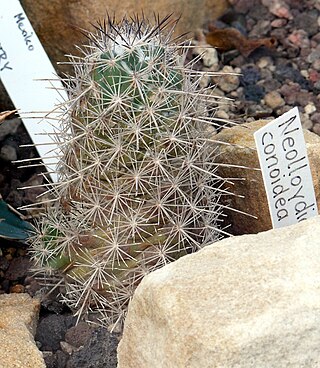
Cochemiea is a genus of cactus. It has previously been synonymized with Mammillaria, but molecular phylogenetic studies have shown that when broadly circumscribed, Mammillaria is not monophyletic, and Cochemiea has been accepted as a separate genus. Cactaceae is the 5th most endangered plant or animal family globally evaluated by the International Union for the Conservation of Nature.
Neolloydia is a formerly recognized genus of cacti. The genus was first erected by Britton and Rose in 1922. Edward F. Anderson regarded Neolloydia as being poorly defined, with the result that species that had at times been included in Neolloydia were afterwards placed in multiple genera, including Coryphantha, Echinomastus, Escobaria, Mammillaria, Sclerocactus, Thelocactus and Turbinicarpus. In his 2001 book, Anderson firmly placed only one species in the genus, Neolloydia conoidea, with another, Neolloydia matehualensis, being regarded as only a variant of N. conoidea. As of December 2022, Plants of the World Online treated Neolloydia conoidea as a synonym of Cochemiea conoidea, and Neolloydia as a synonym of Cochemiea.

Cochemiea macdougallii is a species of cactus in the genus Cochemiea.

Cacteae is a tribe of plants of the family Cactaceae found mainly in North America especially Mexico. As of August 2018, the internal classification of the family Cactaceae remained uncertain and subject to change. A classification incorporating many of the insights from the molecular studies was produced by Nyffeler and Eggli in 2010. The main threats to cactus species are poaching, farming, mining developments, and climate change.

Fishhook cactus is a common name for any hook-spined species of the genera Mammillaria, Echinomastus, Sclerocactus, or Cochemiea. They are small cacti, usually growing up to 6-7 inches (20 cm) high, and are shaped similar to a barrel cactus. They are not to be confused with the fishhook barrel cactus of the Sonoran and Chihuahuan Deserts. The Fishhook cactus is a large category of around 150 species.

Cochemiea dioica, also called the strawberry cactus, California fishhook cactus, strawberry pincushion or fishhook cactus, is a cactus species of the genus Cochemiea. Its common name in Spanish is biznaga llavina. Temperature along with precipitation are consequential factors in distributing plant species.

Cochemiea tetrancistra is a species of fishhook cactus known by the common name common fishhook cactus. It is native to the Mojave and Sonoran Deserts of northern Mexico and the southwestern United States, where it grows in a variety of desert habitat types.

Cochemiea multidigitata is a species of flowering plant in the family Cactaceae that is endemic to San Pedro Nolasco Island in Mexico, growing on steep slopes. Cochemiea multidigitata sprouts a white to cream-colored flower from spring to early summer.

Cochemiea grahamii is a species of cactus also known by the names Arizona fishhook cactus and Graham's nipple cactus.

Cochemiea conoidea, common name Texas cone cactus or Chihuahuan beehive, is a species of cactus native to western Texas and to the Mexican states of Coahuila, Durango, Nuevo León, San Luis Potosí, Tamaulipas, and Zacatecas. It is a part of the Chihuahuan Desert desert scrub and the Tamaulipan thorn scrub.

Cochemiea boolii is a species of cactus in the subfamily Cactoideae with pink-petaled flowers.

Cochemiea mainiae is a species of cactus in the subfamily Cactoideae, with the common name counterclockwise nipple cactus.

Cochemiea goodridgei is a species of plant in the family Cactaceae. It is endemic to Mexican state Baja California. It is also spelled as goodridgii and goodrichii. It was named after John Goodridge.

Ferocactus gracilis, the fire barrel cactus, is a species of Ferocactus from Northwestern Mexico. This cactus gets its common name from the striking red coloration of its defensive spines and flowers.

Cochemiea wrightii is a species of Cochemiea found in Mexico and the southern United States.

Cochemiea blossfeldiana is a species of Cochemiea found in Mexico.

Cochemiea maritima is a species of Cochemiea found in Mexico.

Cochemiea poselgeri is a species of Cochemiea found in Mexico

Cochemiea saboae is a species of Cochemiea found in Mexico.

Cochemiea insularis is a species of Cochemiea found in Mexico.



















